“The Student Role: Placing Memory in High River”
Brittany Alonso, Ambrose University History Graduate
Panel: Placing Memory in High River: An Oral History Project
Conference: Alberta Museum Association Conference—A Culture of Sharing: Inquiring Minds, Empowering Museums, Calgary, September 16, 2016.
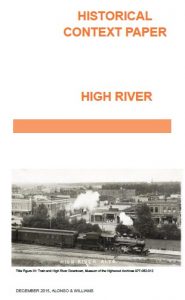
My role in the project in conjunction with conducting oral history interviews was to research and gather the background information on High River and to write the context paper. The context paper was primarily a part of the Heritage Inventory Project (HIP), which was a precursor to the Placing Memory Project. Through the information collected throughout the first two phases of the HIP, we were able to gather the information that we needed for the context paper as well as identify important buildings and key places of memory. During the research process, there were many times that we needed to refer back to the Phase I and Phase II final reports for information on certain residential or downtown buildings such as the Wallace Residence or the Koch Pflughaupt or Bradley Buildings. These two final reports became essential in gathering evidence and were vital reference documents. Not all of the buildings identified in the HIP Phase I and II final reports were used in the Placing Memory Project but it gave a sense of direction on which buildings we wanted to touch on and explore for the project.
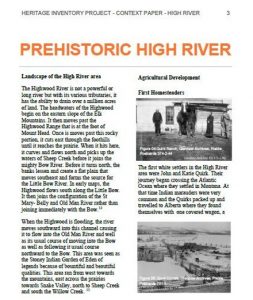 It was a very challenging yet a completely rewarding task and one that I will look back on with satisfaction. The context paper gave an overview of the history of High River starting from what we labeled as prehistoric High River. This explores the native influence on the town as well as the significance that the region had to the multiple First Nations tribes such as the Blackfoot and Stoney tribes that roamed the area. The paper then explored the influence that farmers and ranchers had upon the town as well as the urban and residential development that High River underwent and the progress that was made as time went on. It investigated aspects of the town such as leisure, sports, spiritual life and the involvement and connection that High River had in the First and Second World Wars.
It was a very challenging yet a completely rewarding task and one that I will look back on with satisfaction. The context paper gave an overview of the history of High River starting from what we labeled as prehistoric High River. This explores the native influence on the town as well as the significance that the region had to the multiple First Nations tribes such as the Blackfoot and Stoney tribes that roamed the area. The paper then explored the influence that farmers and ranchers had upon the town as well as the urban and residential development that High River underwent and the progress that was made as time went on. It investigated aspects of the town such as leisure, sports, spiritual life and the involvement and connection that High River had in the First and Second World Wars.
The steps involved with writing the context paper were numerous. My partner and I used the context paper from the community of Blairmore as our guide to see how it was constructed and organized. We looked at their basic layout and then chose the categories that were best suited to the town of High River as well established categories of our own. We then developed an outline, which needed approval by the steering committee before we could proceed with the research process. In addition to the creation of an outline, a master list of locations and buildings was created to give a clearer idea of the places that we wanted to discuss during the oral history interviews.
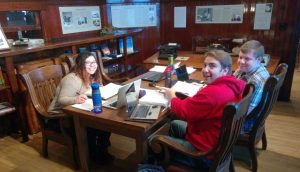
Much of the material that we used for the context paper came from local history books and was supplemented with material and information gathered from the archive of the Museum of the Highwood. Researching was the most time consuming yet one of the most insightful parts of my involvement with the project. The biggest difficulty that I found was combing through the years of information that is stored in the archive and how to sort through all of the documents, newspaper articles and books to uncover the relevant yet interesting information.
Interviews
The part that I struggled with the most was the oral history interviews. While it was a good experience, I was nervous as many people are when they are put into a room with a stranger and they are being interviewed. It gave me great insight into how High River has changed. It was interesting to hear the numerous stories that emerged and the different perspectives that everyone had. It showed me the diversity of experiences that happen in such a small town like High River. It also showed me how important and influential that the buildings of High River were on the residents of the town. It was refreshing to hear about the deep sense of community that was evident in the earlier times in High River. In many ways that feeling and sense of community has been lost in many towns in the present age. The interviews provided a window into a simpler time in the past.
History Harvest
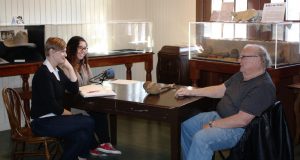
The History Harvest is a celebration of the local history. The goal of it is to preserve, collect and share local history. It is a mixture of show and tell similar to what we all did in elementary school and The Antiques Road Show by explaining the importance of an item on a personal level as well as exploring the historical significance in regards to the local community. The exhibition of the History Harvest and the subsequent digital archive and online exhibit was created to share with the public the results from the Harvest and the collection of the objects of memory as a way to “celebrate the past and to preserve the memories of yesterday with the generations of tomorrow.”
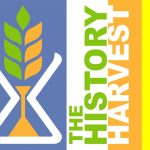
The History Harvest that we conducted was only one part of a larger whole. It is a collective effort and made up of a series of historical artifacts from local community around the United States and Canada that are then placed into a digital archive. Our History Harvest was held last year (2015) on the 21st of November. Members of the community were invited to bring their historical objects to the Museum of the Highwood. Every member was interviewed and asked about their artifact and the stories and significance connected to each item. The responses were documented both digitally and physically. The digital documentation and photographs of the items were placed in a digital archive and then later in an online exhibit. The concept of the History Harvest began with the University of Nebraska and their desires to explore local history through the stories associated with the belongings of community members.
Throughout the day, it was interesting and enlightening to hear the diverse stories behind the artifacts that people brought in. Each participant had a sense of pride and wanted to share the personal historical significance of the individual items and how it was involved in some way around the history of or in High River. The History Harvest was a very unique experience to be involved in and to once again see the partnership between the university and the community. The Harvest showcased how important simple objects can be to a person as well as how vital the stories linked to the artifacts are to the individual owners. It a greater extent, these stories are linked to the town as a whole. A wide variety of items were brought in such as photos, household items, local history books, family heirlooms, personal keepsakes and even the cross that hung in the sanctuary of the local Nazarene church. The community members seemed very eager to share their stories with us. Even the small seemingly insignificant items such as a plate or a silver ring held extreme importance for the people that owned them.
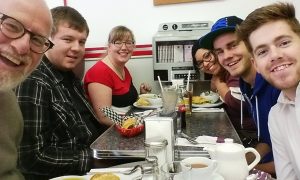
What was good?/Project takeaways
One of the highlights from my time working on the project was the fact that members of the community were involved in the interviewing process. It created a greater sense of teamwork rather than a feeling of separation between university history student researchers and community participants. Another positive element was that by exploring the buildings and the stories surrounding them (the built environment), it is easier to remember the specific and general details associated with each of the buildings and places around High River rather than trying to remember a specific time and the memories linked with that time period. The broader the topic, the easier it is to remember what happened.
The biggest lesson I took away from my involvement with the Placing Memory project was how it changed my entire outlook on what archival research is and what it entails. Going into the project I had a very narrow view of what went into the research process. It was more than just finding a book or article on the subject but that is it actually the collection of raw data that needs to be sorted through. Archival research assaults you with a plethora of information. Some of it is relevant and some of it, while interesting, can be unrelated to your research topic. A huge lesson was that it is important to remember to not get overloaded and overwhelmed with the information. By participating in the project is has assisted in honing my research skills and creating a rhythm I could follow as I went through the archived material. Over time it became easier to choose what was important and worth copying down.
It was a valuable experience and through it, I gained the knowledge on how to work through a pile of seemingly random information and to pull out the necessary facts. The knowledge that I have gathered has helped me in many ways. For example, through sorting through these facts, I was able to paint a more coherent picture on what life was like in early High River and the progress that it has made as a town and a community. By doing the archival research it unearthed and opened by eyes to many fascinating stories that otherwise would have stayed buried. These fascinating stories tend to go under the radar because people want to know the general or larger facts rather than sift through the mundane. Stories that come out from the happenings of everyday life are with knowing because they give the greatest insight into what life was really like. They paint the clearest and most real picture of what happened. They are the primary sources are often the most vital when doing history. A key lesson I took from the project was, when doing research, I need to sympathize and acknowledge that the stories belong to other people and what was acceptable then would not necessarily be acceptable now.
